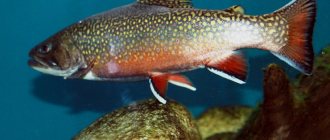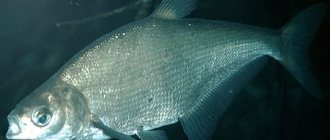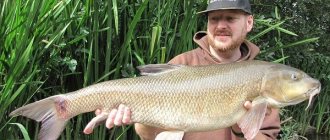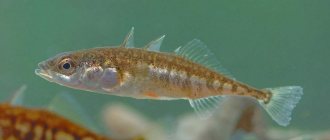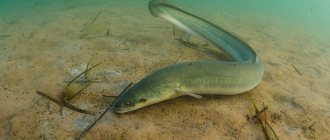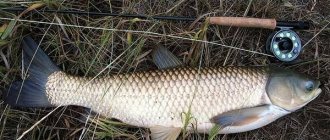What is cupid? For many, this word should be capitalized and mean a river. But the black carp fish received its Russian name not by chance. After all, it is familiar to us, since it was originally found in this river. The scientific name of the species is Mylopharyngodon piceus. But people call the fish Chinese roach. In the Celestial Empire it is very common and is an object of industrial fishing. There it is actively bred in ponds. In Russia, the fish is rare and is on the verge of extinction. In this article we will talk about black carp. Where are the fish found, what are their habits, what do they bite on. There is also a close relative of black carp in Russian reservoirs - the white one. What is the difference between the types? You will find out if you read this article to the end.
Scientific description of the species
Black carp is a fish of the Carp family, a species of ray-finned fish. It is found in abundance in the rivers and lakes of China and the Far East. The species' habitat extends to southern China. Cupid is a large fish. Its body reaches more than a meter in length, and its weight is up to thirty kilograms. This fish is freshwater, but it also thrives in a slightly brackish environment, and therefore is found at the mouth of rivers. Black carp have one peculiarity: with age, the head, fins and even the diameter of the eyes decrease. The adult is a fish with a moderately elongated body covered with large scales. The Chinese roach has a special tooth structure that is not characteristic of other Karpovs. Cupid easily breaks shells of mollusks - they constitute its main diet. The Chinese roach also likes to eat small marine organisms and insect larvae. Moreover, this fish is very voracious. An adult can eat two kilograms of shellfish in a day.
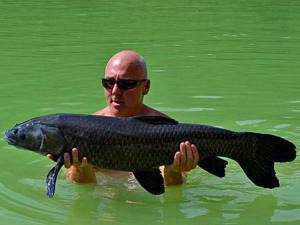
Order Lampreys (Petromyzontiformes (Berg, 1940))
List of the lamprey family (Petromyzontidae (Bonaparte, 1831))
The Lamprey family is represented in the Amur basin by two species belonging to the genus Pacific lampreys (Lethenteron Creaser (et Hubbs, 1922)). Lampreys are not fish. They are representatives of an independent, very ancient and primitive class of cyclostomes.
1 Pacific lamprey (Lethenteron camtschaticum (Tilesius, 1811))

Pacific lamprey
2 Far Eastern brook lamprey (Lethenteron reissneri (Dybowski, 1869))

Far Eastern brook lamprey
What is the difference between grass carp and black carp?
Even a child can answer this question. Well, of course, color. Faringodon (the common name for carp) includes only two species: Ctenopharyngodon idella (grass carp) and Mylopharyngodon piceus (black carp). The fish are similar in body structure and habits. But it’s not just their color that distinguishes them. Grass carp is completely herbivorous. Therefore, it is often bred together with other cyprinids, because this type of fish does not pretend to be their food supply. Grass carp was acclimatized for this property in the 60s of the last century and in the European part of the USSR. Now it is found in western Russia, Ukraine, other European countries and Kazakhstan. Black carp also became an inhabitant of the Volga, Dnieper, and rivers in southern Siberia. Black carp, unlike white carp, has a very dark body and a lighter belly. Its brother only has dark fins. Its back and sides are golden, and its belly is yellowish-gray or greenish.
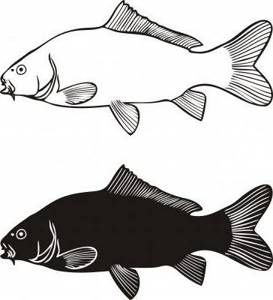
Family Catfish (Siluridae (Rafinesque, 1815))
The Amur family Catfish has only 2 species.
Amur catfish (Silurus asotus (Linnaeus, 1758))
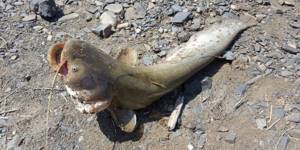
Amur catfish
Soldatov's catfish (Silurus soldatovi (Nikolsky et Soin, 1948))
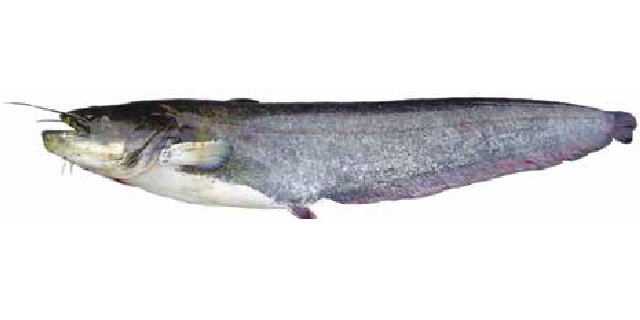
Som Soldatova [2]
The benefits of black carp
In its homeland, Chinese roach is specially bred in ponds and drainless reservoirs. Black carp feeds mainly on mollusks, and they are known to be the main carriers of helminths. Therefore, he is kept in ponds as a “pond nurse.” Black carp is also valued for its rapid growth. Although the fish becomes sexually mature only at seven or eight years of age, it reaches a length of half a meter already in the fifth year of life. Chinese roach meat is very tasty and dietary. Its energy value is only 88 kcal (grass carp has 134). The meat is boneless, tender and juicy. It contains polyunsaturated omega-6 acids, sodium, phosphorus, potassium, calcium and other valuable minerals, as well as vitamins A, B complex, C and E.
Chinese roach in cooking
Black carp began to be bred in Europe not only for its qualities as a “reservoir cleaner”. Its meat has exceptionally wonderful taste. In China, black carp is a favorite dish. It is boiled, fried, baked, in a word, subjected to all types of culinary processing. There are few bones in it, the fish is easy to clean. But professional chefs say that Chinese roach is best baked on the grill or in the oven. The liver of this fish is also eaten. It is believed to have healing properties.
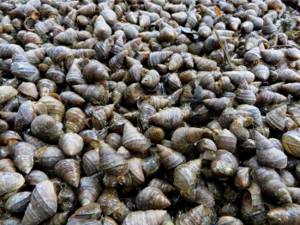
List of fish of the killer whale family (Bagridae (Bleeker, 1858))
Killer whales inhabit the fresh waters of Africa and Asia. The northern border of the family's distribution is the river. Amur, home to 5 species of killer whales.
Little killer whale, or Gromov's killer whale (Tachysurus argentivittatus (Regan, 1905))

Killer whale (junior synonym – Tachysurus mica (Gromov, 1970)) [2]
Lash killer whale, or Ussuri killer whale (Tachysurus ussuriensis (Dybowski, 1872))
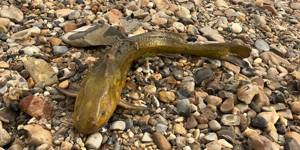
Lash killer whale, or Ussuri killer whale
Chinese Creaking Killer Whale (Tachysurus sinensis Lacepède, 1803)

Chinese Creaking Killer Whale
Herzenstein's killer whale (Tachysurus herzensteini (Berg, 1907))
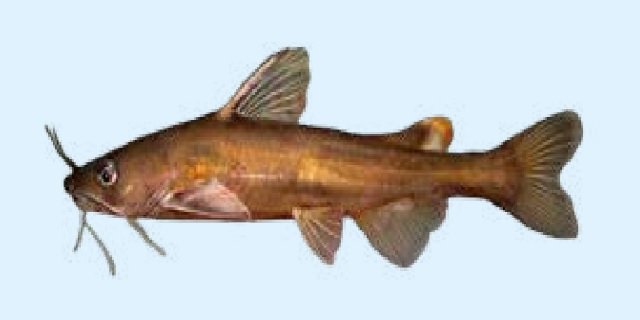
Herzenstein's killer whale
Brazhnikova's killer whale (small or blue) (Tachysurus brashnikowi (Berg, 1907))

Orca Brazhnikova
Where is it found and what to use to catch black carp
In winter, the Chinese roach hides in bottom holes and, covered with mucus, hibernates. In spring, adults go to the floods. They prefer ponds overgrown with reeds. The fish does not look for great depths and stays near the shore, feeding on bottom mollusks. Mainly snails and river mussels are used for bait. The best bite is after spawning and in August, during the daytime. While any plant food is suitable for catching grass carp, its black counterpart is more picky about food. And also careful. For bait you can use pearl barley and earthworm. All cupids are very strong fish, so you should stock up on reliable gear. The bait is attached to hooks starting from size six. The nozzle should be the size of a pea to the size of a walnut. The fisherman must have a strong fishing line with a leader of at least 0.30 millimeters. It is best to use a bottom fishing rod, but you can also fish with a regular one with a float. You should know that black carp is an endangered species. It is on the verge of destruction in Russia, and therefore its fishing is prohibited.
Family Ictaluridae (Gill, 1861)
Channel catfish (Ictalurus punctatus (Rafinesque, 1818))
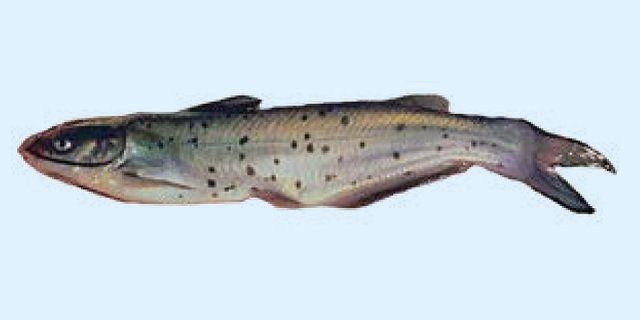
Channel catfish (Ictalurus punctatus (Rafinesque, 1818)) [4]
American catfish. Until recently, the family was purely American.
Aquaculture facility. Currently widely distributed in fish farms around the world.
In the Amur basin it is bred in the village. Luchegorsk in a fish farm.
Balitoridae (List of fish of the family Balitoridae, or Balitoridae)
The list of representatives of the Balitoridae family in the Amur includes 3 species. Balitoridae are a family of ray-finned fish from the order Cyprinidae.
Round-tailed loach (Barbatula nudus (Bleeker, 1865)) Round-tailed loach [2]
Siberian Whiskered Loach (Barbatula toni (Dybowski, 1869)) Siberian Whiskered Loach [2]
Eight-tailed loach, or lefua (Lefua costata (Kessler, 1876))
Eight-tailed loach, or lefoi [2]
Belontiidae (Family Belontiaceae) - Macropodinae (Subfamily Macropod-like)
In the Amur, the Belontiaceae subfamily is represented by one species: Macropodus chinnesis Bloch, 1790, otherwise Macropodus ocellatus, Macropodus hongkongensis. By the way, the rarest macropod.
Chinese macropod (Macropodus chinensis (Bloch, 1790))
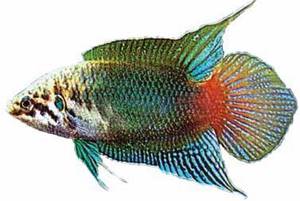
Chinese macropod [2]
Channidae (Family Snakeheads)
In the Amur, the Snakehead family is represented by only one species.
Snakehead (Channa argus (Cantor, 1842))
Snakehead [2]
Cobitidae (List of fishes of the family Loach family)
The list of representatives of the Loach family in the Amur includes 9 species. Loaches are a family of ray-finned fish from the order Cyprinidae.
Choi's spined loach (Cobitis choii (Kim et Son, 1984))

Choi's picker [2]
Luther's spined loach (Cobitis lutheri (Rendahl, 1935))
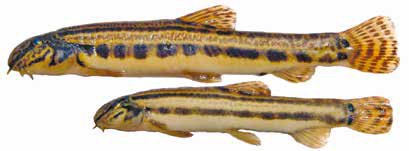
Luther pinching [2]
Siberian spined loach (Cobitis melanoleuca (Nichols, 1925)) Siberian spined loach [2]
Chinese spined loach (Cobitis sinensis (Sauvage & Dabry de Thiersant, 1874))
Leptobotia mantschurica (Berg, 1907)) Leptobotia [2]
East Asian loach (Misgurnus anguillicaudatus (Cantor, 1842))
Loach Mogoit (Misgurnus mohoity (Dybowski, 1868)) Loach Mogoit [2]
Nikolsky's loach ((Misgurnus nikolskyi Vasilieva, 2001)) Nikolsky's loach [2]
Dabry loach (Paramisgurnus dabrianus (Guichenot in Dabry de Thiersant, 1872))
Vyun Dubri [2]
